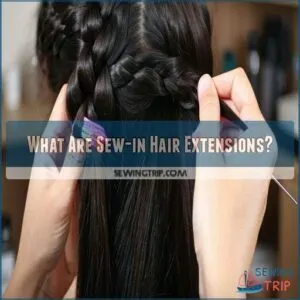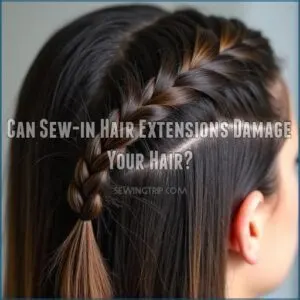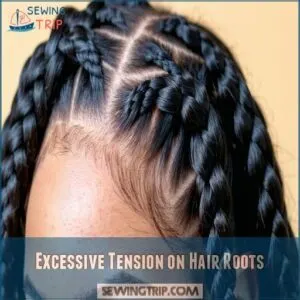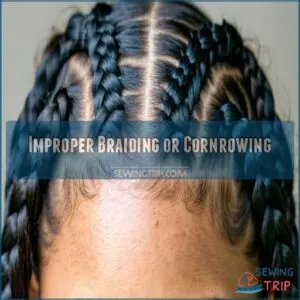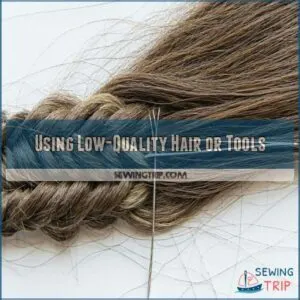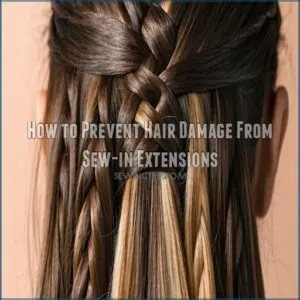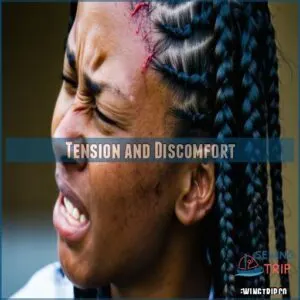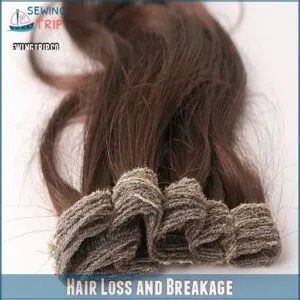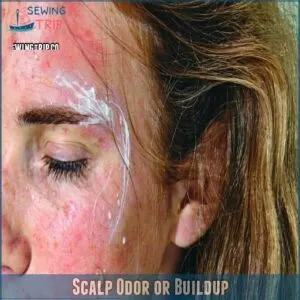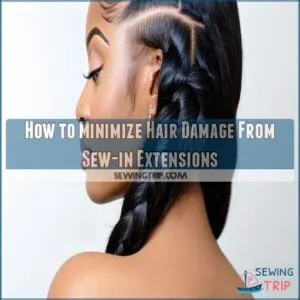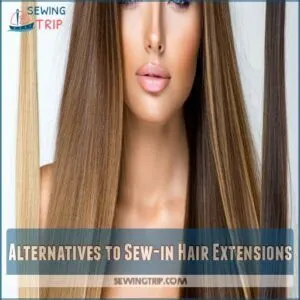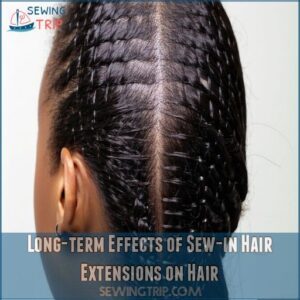This site is supported by our readers. We may earn a commission, at no cost to you, if you purchase through links.

You’re in control – the key lies in choosing a skilled stylist and maintaining proper care.
Think of extensions like a house: the foundation (your natural hair) needs proper support and maintenance.
When done right, sew-ins can actually help you enjoy activities like swimming with your extensions, using tips on how to go swimming with a sew in, and protect your natural hair while giving you the length and volume you want.
Your scalp’s comfort is the best indicator – any persistent pain or tension means something’s not right.
There’s more to the story regarding keeping your natural hair healthy underneath.
Table Of Contents
- Key Takeaways
- What Are Sew-in Hair Extensions?
- Can Sew-in Hair Extensions Damage Your Hair?
- Causes of Hair Damage From Sew-in Extensions
- How to Prevent Hair Damage From Sew-in Extensions
- Signs of Hair Damage From Sew-in Extensions
- How to Minimize Hair Damage From Sew-in Extensions
- Alternatives to Sew-in Hair Extensions
- Importance of Professional Installation and Maintenance
- Long-term Effects of Sew-in Hair Extensions on Hair
- Frequently Asked Questions (FAQs)
- Conclusion
Key Takeaways
- You won’t automatically damage your hair with sew-in extensions, but improper installation can cause traction alopecia and breakage.
- You’ll need regular maintenance every 4-6 weeks and should give your hair a 2-3 week break between installations to prevent scalp damage.
- You should stop wearing the extensions if you experience persistent pain, scalp odor, unusual buildup, or notice signs of hair thinning and breakage.
- You’re better off choosing a qualified stylist who charges $200-$800 for installation than risking permanent hair loss from inexperienced installation.
What Are Sew-in Hair Extensions?
Sew-in hair extensions, or weaves, involve sewing hair wefts onto braids created from your natural hair. This method can add volume and length, offering a natural look when installed correctly.
Definition and Process
Sew-in hair extensions, which involve a process of preparing for a sew-in weave, often called weaves—involve sewing hair wefts onto braided patterns in your natural hair.
Imagine painting a masterpiece on a carefully primed canvas.
The process begins with braiding your hair to lie flat against the scalp, creating a sturdy base.
Then, hair wefts are seamlessly attached using a needle and thread, offering a natural look.
Benefits and Types of Sew-ins
With sew-in extensions, you’re getting a longer-lasting, versatile hairstyle.
Think of them as a protective style; they shield your natural hair.
However, improper installation or removal can lead to hair weave damage solutions, so it’s important to find a skilled stylist.
Sew-in types offer various looks, from sleek and straight to voluminous curls.
The sew-in lifespan is typically 6-8 weeks, but proper sew-in maintenance extends that.
Expect a higher sew-in cost upfront, but it’s often more economical long-term than frequent salon visits.
Numerous sew-in styles are possible!
Choosing The Right Hair for Sew-ins
Choosing the right hair for sew-ins can be like finding the perfect pair of jeans; it just has to fit right.
You should consider your hair type and texture match to guarantee natural blending.
Decide between Remy and synthetic based on budget and look, and don’t forget to pick the right hair length and color for a seamless style.
Can Sew-in Hair Extensions Damage Your Hair?
Sew-in hair extensions, which involve sewing wefts into braids, can potentially cause damage if not installed and maintained correctly. Understanding traction alopecia and ensuring proper care are key to preventing hair loss and damage. To minimize damage when working with hair, especially with tools like high-quality hair scissors, understanding traction alopecia and ensuring proper care are key to preventing hair loss and damage.
Traction Alopecia and Hair Loss
Understanding sew-in extensions means knowing traction alopecia, where tight applications pull hair and potentially damage follicles.
To prevent damage, use gentle installation methods such as weave caps for reduced tension and learn how to protect edges with sew in.
Protect your locks and avoid hair loss by following these steps:
- Monitor Tension: If it feels too tight, it probably is!
- Rotate Styles: Switch up your partings and braiding patterns.
- Seek Professional Advice: Don’t hesitate to consult a stylist if you notice any breakage.
Damage From Improper Installation
Improper installation can wreak havoc on your hair.
Picture tight braiding pulling on your roots, causing scalp irritation.
Add a weave that’s too heavy or sewn with the wrong needle size, and you’re asking for trouble.
Always seek a professional to avoid these pitfalls, ensuring your extensions are a beautiful boost rather than a bothersome burden.
Damage From Improper Maintenance
Neglecting maintenance can unravel your hair extension dreams pretty swiftly. Scalp hygiene is vital—ensure you wash your extensions every 7-10 days to prevent buildup.
Use sulfate-free products, focusing on gentle detangling to avoid dryness and breakage.
Stick to an appropriate wash frequency, and remember, correct product use keeps your extensions looking lush while safeguarding your natural hair.
Causes of Hair Damage From Sew-in Extensions
When considering sew-in extensions, you should know how they can damage your hair. Excessive tension on hair roots, improper braiding, and low-quality tools can all contribute to hair damage.
Excessive Tension on Hair Roots
So, you’re worried about sew-ins damaging your hair. Let’s talk tension.
Too-tight braids and weaves put intense pressure on your hair roots, leading to scalp pain and even tension headaches.
This constant stress can cause follicle damage and hair breakage. Think of it like constantly bending a paperclip—eventually, it snaps.
Gentle tension is key; if it feels tight, it probably is.
Improper Braiding or Cornrowing
When braiding for sew-in extensions, ensuring the right technique is key.
If braids are too tight, they can cause undue stress and harm your hair and scalp health, leading to common issues like those associated with tight braids damage.
Imagine your hair pleading for some relief!
Proper braiding patterns and tightness control help in avoiding discomfort and hair damage.
So, focus on gentle, yet secure braiding methods.
Using Low-Quality Hair or Tools
Grabbing cheap hair or tools leads to quick headaches literally and figuratively.
Hair breakage, knotting issues, and scalp irritation are common.
To avoid these woes, make sure you prioritize quality:
- Choose Remy over synthetic for longer weave lifespan.
- Invest in proper installation tools.
- Match hair texture and color for a natural look.
- Avoid bargain buys that compromise quality.
How to Prevent Hair Damage From Sew-in Extensions
To prevent hair damage from sew-in extensions, you’ll want to focus on proper installation techniques and regular maintenance.
Proper installation and regular maintenance are key to preventing hair damage from sew-in extensions.
Choosing the right type of hair can also make a big difference in maintaining the health of your natural hair.
Proper Installation Techniques
Mastering sew-in extensions starts with the right braiding technique, such as using simple straight back braids or cornrows for a flat foundation, as explained in how to get a flat sew in. Mastering sew-in extensions starts with braiding patterns and tension control.
Opt for neat braids that aren’t too tight to keep hair roots safe.
Track placement matters; space them evenly for balance.
Choose a weft size that’s not too heavy, and use a curved needle to stitch securely but gently.
Proper techniques equal healthy hair and great extensions!
Regular Maintenance and Touch-ups
You’ve aced installation—now what? Keeping sew-ins sleek means maintenance is key. Regular touch-ups keep extensions lively and snug, boosting their lifespan.
Follow this simple plan:
- Aim for touch-ups every 4-6 weeks.
- Use quality maintenance products.
- Balance DIY tasks with salon visits.
- Analyze costs to find what suits you best.
Choosing The Right Type of Hair
When picking hair for sew-in extensions, focus on quality.
Remy hair offers a natural look and longer life, while synthetic is budget-friendly.
Getting a good texture match guarantees a seamless blend with your hair.
Don’t skip on color matching either.
Choose the right extension length for versatility without overwhelming your natural hair.
Signs of Hair Damage From Sew-in Extensions
Recognizing the signs of damaged hair is essential for maintaining healthy locks.
Look out for persistent tension, noticeable hair loss or breakage, and any unusual scalp odor or buildup—these could all signal potential problems.
Tension and Discomfort
You’re dealing with scalp pain from sew-in extensions—those tight braids might be the culprit.
If you notice headaches, itching, or soreness, it’s a sign your extensions are too tight, restricting your comfort.
To manage this, make sure your stylist aims for a snug fit, not a strangle.
A little discomfort is normal, but excessive discomfort isn’t.
Hair Loss and Breakage
Hair loss and breakage can quietly sneak up on you when dealing with sew-in extensions.
Spotting signs early can save your tresses:
- Thinning: Noticeable hair thinning around the extension area.
- Brittle Strands: Fragile hair is more prone to snapping.
- Patchiness: Uneven hair loss may appear.
- Shedding: Increased hair fall during brushing.
These indicators mean it’s time for preventative measures!
Scalp Odor or Buildup
Noticing more breakage now? It’s time to think about scalp odor and buildup.
A neglected cleansing routine leads to product buildup, which affects the scalp’s health and creates unpleasant odors.
Practicing a regular shampoo routine, like the one recommended for curing itchy scalp issues, can help prevent this buildup.
Maintaining scalp hygiene is key.
Use a gentle, sulfate-free shampoo to prevent such issues, ensuring your sew-ins remain fresh and appealing.
Prioritize odor prevention to keep your styles lively and vibrant.
How to Minimize Hair Damage From Sew-in Extensions
To minimize hair damage from sew-in extensions, make sure you’re rotating application areas regularly to reduce stress on the hair.
Also, limit the use of heat styling tools, which can weaken both natural and extension hair.
Rotating Extension Application Areas
Think about the strain and tension constant wear can cause—it’s like wearing the same pair of shoes every day.
Consider also how heat styling affects your leave-out, and learn how to prevent heat damage to keep your sew-in looking and feeling healthy.
Rotating extension application areas is your secret weapon for scalp health and stress management.
For better hair growth:
- Change spots regularly to reduce follicle stress.
- Monitor tension carefully to avoid discomfort.
- Consult with a stylist for smart placement.
Avoiding Excessive Heat Styling
Rotating your extension spots is like giving your hair a breather.
Air drying lead the way, with heatless styling as your sidekick.
Protect with low-heat options or add heat protectants for safety.
Wrap it all up with protective styles and your sew-ins will say thanks by staying fabulous longer.
Alternatives to Sew-in Hair Extensions
If sew-ins aren’t for you, don’t worry!
There are plenty of other ways to add length and volume, like clip-ins, tape-ins, fusion, and micro-ring extensions—each offering different levels of commitment and ease of use.
Clip-in and Tape-in Extensions
Switching up your hair game doesn’t always mean risking damage.
Clip-in extensions offer application ease, cost-effectiveness, and durability without permanent changes.
Tape-in extensions stick for a few weeks, blending beautifully while keeping maintenance low.
With these, you maintain control over your look and minimize hair stress.
Experiment with styles, enjoying the freedom of easy removal and reapplication.
Fusion and Micro-ring Extensions
Fusion and micro-ring extensions offer alternatives to sew-ins, each with unique perks. Fusion involves bonding extensions with adhesive, while micro-rings use tiny rings to attach hair.
They differ in:
- Application Techniques: Fusion uses glue; micro-rings use clamps.
- Cost Comparison: Micro-rings often cost less.
If you’re looking for high-quality fusion hair extension products, check out adhesive fusion hair extensions.
- Maintenance Tips: Regular check-ups needed.
- Long-Term Effects: Less damaging if applied correctly.
Keratin Bonded Extensions
Now, onto keratin bonded extensions!
These might be a smart swap if you’re eyeing alternatives.
They attach to small sections of your hair with a protein keratin adhesive.
They’re less likely to cause damage than sew-ins.
Key perks: easy Keratin bond maintenance, more natural appearance, but pricier.
However, they fit well with various hair types.
Importance of Professional Installation and Maintenance
Choosing an experienced stylist for your sew-in extensions is essential to prevent hair damage.
Regular maintenance appointments help catch issues early.
This keeps your natural hair healthy and the extensions looking their best.
Qualifications and Experience of Stylist
With sew-in extensions, a stylist’s training and experience are your best friends.
Look for certifications and a strong portfolio showcasing their skills.
Customer reviews can offer insight into their reputation.
Don’t just trust anyone with your locks—it’s like letting an untrained chef cook your favorite dish.
Always make sure your stylist has the chops to keep your hair both stylish and healthy.
Regular Maintenance and Check-ups
Just as choosing a skilled stylist matters, regular check-ups help maintain your extension lifespan and scalp health.
Regular salon visits help prevent breakage by keeping extensions secure.
Have your stylist assess root tension and give advice on proper brushing techniques.
These check-ups aren’t just maintenance—they’re key for keeping your hair healthy and extensions looking their best.
Addressing Hair Loss and Damage
Noticing signs of hair loss requires immediate action.
If you’re experiencing tenderness, thinning, or excessive shedding, remove your extensions right away and consult a trichologist or dermatologist.
They’ll assess the damage and create a recovery plan.
Many cases of traction alopecia can be reversed if caught early, but permanent scarring may occur if left untreated.
Don’t wait – your natural hair’s health comes first.
Long-term Effects of Sew-in Hair Extensions on Hair
You’ll want to understand how sew-in extensions can affect your natural hair over time, as improper installation or maintenance may lead to permanent damage.
While extensions can offer beautiful results when done correctly, prolonged tension on your hair follicles can cause traction alopecia, a form of permanent hair loss that’s becoming increasingly common among extension wearers.
Permanent Hair Loss and Scarring
The most serious risk of sew-in extensions is permanent hair loss, known as traction alopecia.
Once hair follicles become scarred from prolonged tension, they won’t grow hair again.
You’ll notice bald patches, particularly around your hairline and temples.
While a professional stylist helps prevent damage, repeated stress on the same areas of your scalp can lead to irreversible follicle scarring.
Hair Thinning and Breakage
Sew-in extensions can gradually lead to noticeable hair thinning and breakage, especially when worn continuously.
Here are key warning signs that your extensions might be causing damage:
- Visible scalp patches where hair used to grow
- Brittle, easily snapping strands near installation points
- Thinning edges around your hairline
- Baby hairs breaking off more frequently
- Split ends appearing closer to your roots
These signs often develop slowly, making them easy to miss until significant damage occurs.
Hair Regrowth and Recovery
Recovery from extension-related hair damage takes time and patience.
Proper installation, such as consulting a professional, is key to minimizing damage.
You’ll typically see new growth within 3-6 months after removal, provided your follicles haven’t been permanently scarred.
Focus on scalp health with gentle massages and nourishing oils to stimulate growth.
If you’re not seeing improvement after 6 months, consult a trichologist – they can assess your scalp and recommend targeted treatments for the best possible recovery.
Frequently Asked Questions (FAQs)
What happens if you don’t put sew-in extensions on your hair?
Like a blank canvas waiting to be painted, your natural hair remains untouched and free.
You’ll avoid potential tension, traction alopecia risks, and monthly maintenance costs.
While keeping your hair’s natural strength intact.
What could be the reason for continuous hair shedding?
Your hair might be shedding due to tight hairstyles, nutritional deficiencies, or stress.
Traction alopecia can be caused by excess tension on your follicles from wearing extensions, leading to continuous hair loss.
Can Sew-in extensions damage your hair?
Sew-in extensions can damage your hair if not installed properly, causing traction alopecia – permanent hair loss from excessive tension.
Regular maintenance, professional installation, and proper care help minimize potential damage.
Should I sew in hair extensions?
With a 15% rise in extension-related hair loss cases, it’s important to weigh your options carefully.
Consider alternatives like clip-ins first, but if you choose sew-ins, work with a certified stylist for proper installation.
Are sew-in weave extensions good for thick hair?
Thick hair provides an excellent foundation for sew-in extensions, offering strong anchor points for braiding.
You’ll enjoy fuller, more dramatic styles, but to achieve undetectable results, try pairing 3a-3c hair textures with straight weaves using heat fusion techniques, but remember to choose extensions that match your natural hair’s thickness for seamless blending.
Why are sew-in hair extensions popular?
You’ll love how sew-in extensions offer versatile styling options and long-lasting results.
They protect your natural hair while providing seamless volume and length.
They can last up to 12 weeks with proper care.
How long should I wait between sew-in installations?
Give your natural hair a 2-3 week break between sew-in installations.
This rest period lets your scalp breathe and helps prevent tension on your hair follicles.
Promoting healthier growth and recovery.
Can swimming or exercise affect my sew-in extensions?
Regular swimming and intense workouts can loosen your sew-in extensions.
Protect them with a swim cap.
Don’t forget to thoroughly dry your hair and scalp afterward to prevent mildew or matting.
Are certain hair types better suited for extensions?
Most hair types work well with extensions, but coarse or textured hair provides better grip for sew-ins.
Fine hair needs gentler application techniques.
Thick hair offers strong anchor points for secure installation.
What products work best with sew-in extensions?
Your sew-in extensions will thank you for using sulfate-free shampoos, moisturizing conditioners, and lightweight leave-in treatments.
Grab a silk pillowcase and extension-specific brush to keep those locks looking fabulous day after day.
How much do professional sew-in extensions typically cost?
Professional sew-in extensions typically cost between $200 to $800, depending on hair quality and stylist expertise. You’ll need to factor in maintenance visits every 4-6 weeks, which run about $100 per session.
Conclusion
Remember the old saying: beauty shouldn’t come at a cost.
While sewing in extensions won’t automatically damage hair, success depends on proper installation and maintenance.
Choose a skilled stylist, maintain regular care, and listen to your scalp’s signals.
If you experience persistent discomfort or notice thinning, it’s time to reassess.
With the right approach, you can enjoy the versatility of sew-in extensions while keeping your natural hair healthy and strong.

